Sawmill
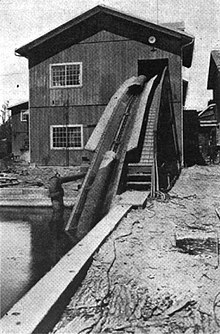
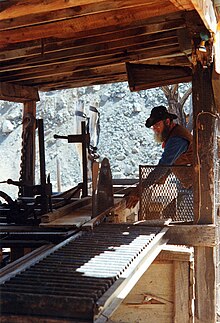
A sawmill is a facility where logs are cut into boards.
Sawmill process
A sawmill's basic operation is much like those of hundreds of years ago; a log enters on one end and dimensional lumber exits on the other end.
- Logging fells (falls) the trees, and log bucking cuts them to length.
- Logs are taken by truck, rail or river to the sawmill.
- Logs are scaled either on the way to the mill or upon arrival at the mill.
- Decking is the process for sorting the logs by species, size and end use (lumber, plywood, chips).
- Debarking removes bark from the logs.
- The head saw, head rig or primary saw, breaks the log into cants (unfinished logs to be further processed) and flitches (unfinished planks) with a smooth edge.
- Depending upon the species and quality of the log, the cants will either be further broken down by a resaw or a gang edger into multiple flitches and/or boards
- Edging will take the flitch and trim off all irregular edges leaving four-sided lumber.
- Trimming squares the ends at typical lumber lengths.
- Drying removes naturally occurring moisture from the lumber. This can be done with kilns or air-dried.
- Planing smooths the surface of the lumber leaving a uniform width and thickness.
- Shipping transports the finished lumber to market.[1]
History
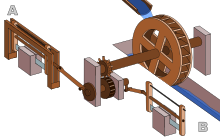

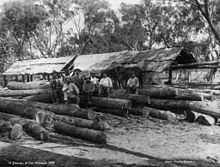
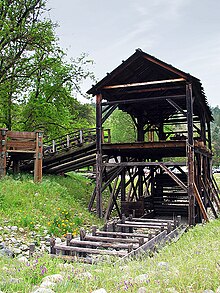
The Hierapolis sawmill, a Roman water-powered stone saw mill at Hierapolis, Asia Minor (modern-day Turkey) dating to the second half of the 3rd century AD is the earliest sawmill. It is also the earliest known machine to incorporate a crank and connecting rod mechanism.[2]
Water-powered stone sawmills working with cranks and connecting rods, but without gear train, are archaeologically attested for the 6th century AD at the Eastern Roman cities Gerasa and Ephesus.[3]
The earliest literary reference to a working sawmill comes from a Roman poet, Ausonius who wrote an epic poem about the river Moselle in Germany in the late 4th century AD. At one point in the poem he describes the shrieking sound of a watermill cutting marble.[4] Marble sawmills also seem to be indicated by the Christian saint Gregory of Nyssa from Anatolia around 370/390 AD, demonstrating a diversified use of water-power in many parts of the Roman Empire.[4]
Sawmills became widespread in medieval Europe again, as one was sketched by Villard de Honnecourt in c. 1250.[5] They are claimed to have been introduced to Madeira following its discovery in c. 1420 and spread widely in Europe in the 16th century.[6]
By the 11th century, hydropowered sawmills were in widespread use in the medieval Islamic world, from Islamic Spain and North Africa in the west to Central Asia in the east.[7]
The sawmill was also described by the Dutchman Cornelis Corneliszoon (1550–1607) by applying a crankshaft onto a windmill, which converted a turning motion into an up-an-down motion. Corneliszoon patented the sawmill on December 15, 1593 and the crank on December 6, 1597. He built the first sawmill there in 1594.
Prior to the invention of the sawmill, boards were rived and planed, or more often sawn by two men with a whipsaw, using saddleblocks to hold the log, and a saw pit for the pitman who worked below. Sawing was slow, and required strong and hearty men. The topsawer had to be the stronger of the two because the saw was pulled in turn by each man, and the lower had the advantage of gravity. The topsawyer also had to guide the saw so that the board was of even thickness. This was often done by following a chalkline.
Early sawmills simply adapted the whipsaw to mechanical power, generally driven by a water wheel to speed up the process. The circular motion of the wheel was changed to back-and-forth motion of the saw blade by a connecting rod known as a pitman arm (thus introducing a term used in many mechanical applications).
Generally, only the saw was powered, and the logs had to be loaded and moved by hand. An early improvement was the development of a movable carriage, also water powered, to move the log steadily through the saw blade.
A small mill such as this would be the center of many rural communities in wood-exporting regions such as the Baltic countries and Canada. The output of such mills would be quite low, perhaps only 500 boards per day. They would also generally only operate during the winter, the peak logging season.
In the United States, the sawmill was introduced soon after the colonisation of Virginia by recruiting skilled men from Hamburg. Later the metal parts were obtained from the Netherlands,[8] where the technology was far ahead of that in England, where the sawmill remained largely unknown until the late 18th century. The arrival of a sawmill was a large and stimulative step in the growth of a frontier community.
Early mills were taken to the forest, where a temporary shelter was built, and the logs were skidded to the nearby mill by horse or ox teams, often when there was some snow to provide lubrication. As mills grew larger, they were usually established in more permanent facilities on a river, and the logs were floated down to them by log drivers.
The next improvement was the use of circular saw blades, and soon thereafter, the use of gangsaws, which added additional blades so that a log would be reduced to boards in one quick step. Circular saw blades were extremely expensive and highly subject to damage by overheating or dirty logs. A new kind of technician arose, the sawfiler. Sawfilers were highly skilled in metalworking. Their main job was to set and sharpen teeth. The craft also involved learning how to hammer a saw, whereby a saw is deformed with a hammer and anvil to counteract the forces of heat and cutting. The circular saw was a later introduction, perhaps invented in England in the late 18th century, but perhaps in 17th century Holland (Netherlands). Modern circular saw blades have replaceable teeth, but still need to be hammered.[9]
The introduction of steam power in the 19th century created many new possibilities for mills. They could be built away from water and could be far more mechanized. Scrap lumber from the mill provided a ready fuel source for firing the boiler. Efficiency was increased, but the capital cost of a new mill increased dramatically as well.
In addition, the use of steam or gasoline-powered traction engines also allowed the entire sawmill to be mobile. [10][11]
By 1900, the largest sawmill in the world was operated by the Atlantic Lumber Company in Georgetown, South Carolina, using logs floated down the Pee Dee River from as far as the edge of the Appalachian Mountains in North Carolina.
A restoration project for Sturgeon's Mill in Northern California is underway, restoring one of the last steam-powered lumber mills still using its original equipment.
Current trends

In the twentieth century the introduction of electricity and high technology furthered this process, and now most sawmills are massive and expensive facilities in which most aspects of the work is computerized. The cost of a new facility with 2 mmfbm/day capacity is up to CDN$120,000,000. A modern operation will produce between 100 mmfbm and 700 mmfbm annually.
Small gasoline-powered sawmills run by local entrepreneurs served many communities in the early twentieth century, and specialty markets still today.
A trend is the small portable sawmill for personal or even professional use. Many different models have emerged with different designs and functions. They are especially suitable for producing limited volumes of boards, or specialty milling such as oversized timber.
Technology has changed sawmill operations significantly in recent years, emphasizing increasing profits through waste minimization and increased energy efficiency as well as improving operator safety. The once-ubiquitous rusty, steel conical sawdust burners have for the most part vanished, as the sawdust and other mill waste is now processed into particleboard and related products, or used to heat wood-drying kilns. Co-generation facilities will produce power for the operation and may also feed superfluous energy onto the grid. While the bark may be ground for landscaping barkdust, it may also be burned for heat. Sawdust may make particle board or be pressed into wood pellets for pellet stoves. The larger pieces of wood that won't make lumber are chipped into wood chips and provide a source of supply for paper mills. Wood by-products of the mills will also make oriented strand board (OSB) paneling for building construction, a cheaper alternative to plywood for paneling.
Additional Images
-
Inside a modern sawmill equipped with laser-guided technology
-
Wood traveling on sawmill machinery
-
Sawdust waste from the mill
-
Wood from Victorian mountain ash, Swifts Creek
-
An Allis-Chalmers Model B with a saw mill style mechanism mounted on the back
-
A sawmill in Armata, on mount Smolikas, Epirus, Greece.
-
A preserved water powered sawmill, Norfolk, England.
See also
References
- ^ "Lumber Manufacturing". Lumber Basics. Western Wood Products Association. 2002. Retrieved 2008-02-12.
- ^ a b Ritti, Grewe & Kessener 2007, p. 161
- ^ Ritti, Grewe & Kessener 2007, pp. 149–153
- ^ a b Wilson 2002, p. 16
- ^ C. Singer et at., History of Technology II (Oxford 1956), 643-4.
- ^ Charles E. Peterson, 'Sawdust Trail: Annals of Sawmilling and the Lumber Trade' Bulletin of the Association for Preservation Technology Vol. 5, No. 2. (1973), pp. 84-5.
- ^ Adam Robert Lucas (2005), "Industrial Milling in the Ancient and Medieval Worlds: A Survey of the Evidence for an Industrial Revolution in Medieval Europe", Technology and Culture 46 (1): 1-30 [10-1]
- ^ Peterson, 94-5.
- ^ Norman Ball, 'Circular Saws and the History of Technology' Bulletin of the Association for Preservation Technology 7(3) (1975), pp. 79-89.
- ^ Edwardian Farm: Roy Hebdige's mobile sawmill
- ^ Steam traction engines
Sources
- Grewe, Klaus (2009), "Die Reliefdarstellung einer antiken Steinsägemaschine aus Hierapolis in Phrygien und ihre Bedeutung für die Technikgeschichte. Internationale Konferenz 13.−16. Juni 2007 in Istanbul", in Bachmann, Martin (ed.), Bautechnik im antiken und vorantiken Kleinasien (PDF), Byzas, vol. 9, Istanbul: Ege Yayınları/Zero Prod. Ltd., pp. 429–454, ISBN 978-975-807-223-1
- Ritti, Tullia; Grewe, Klaus; Kessener, Paul (2007), "A Relief of a Water-powered Stone Saw Mill on a Sarcophagus at Hierapolis and its Implications", Journal of Roman Archaeology, vol. 20, pp. 138–163
- Wilson, Andrew (2002), "Machines, Power and the Ancient Economy", The Journal of Roman Studies, vol. 92, pp. 1–32







